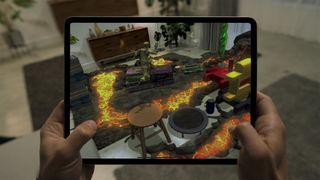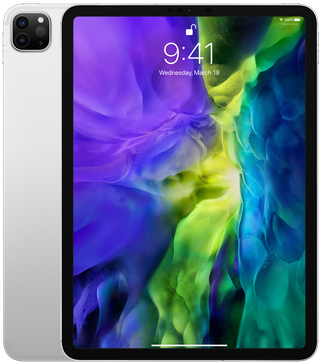iPad Pro (2020): Everything you need to know

Apple has announced the fourth-generation iPad Pro, complete with an updated processor, a new dual rear camera setup, and a LiDAR (Light Detection and Ranging) sensor. Alongside these new iPad Pros, Apple also announced the new Magic Keyboard accessory, which brings a full trackpad to the iPad for the first time.
Here's everything you need to know.
So there's a new iPad Pro?
That's right! Apple has announced the fourth-generation iPad Pro. It has a new chip (though not an A13X that many of us expected), a brand new set of cameras, and, for the first time on an Apple device, a LiDAR sensor for depth sensing and augmented reality.
Are there any size changes with the new iPad Pro?
While in the past Apple has consistently changed the size of the smaller of the iPad Pros (first was 9.7 inches, the second was 10.5, and the third was 11 inches), this time around, Apple is keeping things pretty steady. The fourth-generation iPad Pro comes in 11- and 12.9-inch models.
What's going on with the cameras?
The rear-facing cameras are the biggest changes in this generation of iPad Pro, at least on the hardware side of things. Like the iPhone 11, the iPad Pro now sports two cameras on the back, though this is a different camera system than the iPhone 11.
The iPad Pro still sports a wide-angle camera with a 12MP sensor (what you might call the 'Apple standard' camera), along with a second, 10MP super-wide camera. The iPad Pro can shoot video at up to 4K at 24, 30, and 60 fps on the wide camera, and 60 fps on the ultra-wide.
Importantly, the new, larger camera bump is also home to the iPad Pro's new LiDAR sensor.
Master your iPhone in minutes
iMore offers spot-on advice and guidance from our team of experts, with decades of Apple device experience to lean on. Learn more with iMore!
As for the front-facing camera, it's still the same 7MP camera with the TrueDepth sensor suite that was found on the last iPad Pro.
What is a LiDAR sensor and why is it on the iPad Pro?
LiDAR, short for Light Detection and Ranging, is a technology that uses reflected light to collect information on distance. The sensor sends out a ping, then uses time-of-flight calculations to determine how far away something is. The sensor in the iPad Pro can detect objects up to five meters (16.4 feet) away.
According to Apple, the LiDAR sensor works not only with the cameras, but also the iPad's motion sensors and software frameworks to measure depth information. The purpose, as Apple puts it, is to make the iPad Pro the best device out there for augmented reality.
How will LiDAR help with augmented reality?
Because of the enhanced depth-sensing capabilities provided by LiDAR, everything you do with augmented reality can happen more accurately and quickly. Placing objects is faster, and AR objects can now pass both in front of and behind real-world objects. Developers will also be able to take advantage of the LiDAR sensor when developing AR apps.
What's going on with the A12Z processor?
While many (including myself) would have expected an A13X in this iPad Pro, Apple has thrown a bit of a curveball with the A12Z. We don't have a full picture of what exactly this means just yet, but we're not completely in the dark.
The A12X used four high-power cores and four power-efficient cores, and it's likely that the A12Z has a similar setup. The only solid piece of information that Apple has given us on the A12Z so far is that it features an 8-core GPU, which is a step up from the A12X's seven cores.
The A12Z also features the M12 motion coprocessor, along with Apple's neural engine for on-device machine learning.
Is there a new Apple Pencil?
No. Apple is sticking with the second-generation Apple Pencil this time around. The iPad Pro still features a magnetic inductive charging area on one side that both stores and charges the Apple Pencil when it's not in use.
What about keyboards? Are there new keyboards?
Oh boy, are there. First, there's the standard Smart Keyboard Folio, which works just like the previous version: it provides a front and back cover for your iPad Pro when it's folded up for carrying, and it folds out to offer a two-angle keyboard stand when in use.
But the big fish here is the new Magic Keyboard for iPad Pro. It's not coming out until May 2020, but it seems like it's a game-changer for the iPad Pro.
What is the Magic Keyboard for iPad Pro?
The Magic Keyboard for iPad Pro is a new keyboard case, coming in May 2020, that has a trackpad. That's right: as part of iPadOS 13.4, Apple is introducing full trackpad support for the iPad. This works not only with the new Magic Keyboard, but also third-party trackers, as well.
The trackpad on the Magic Keyboard allows for multi-touch navigation, text selection, and more. The cursor is dynamic and built for a touch-first operating system. When you move the cursor over a button, for instance, it highlights that button or icon instead of just hovering on top of it. Move it into a text field, and it helps you highlight text.
But the Magic Keyboard isn't just about the trackpad. The keyboard itself is a scissor-switch design, like the keyboards on the 16-inch MacBook Pro or brand new MacBook Air, and the keys are backlit. Like the standard Smart Keyboard Folio, the back panel of the Magic Keyboard attaches magnetically to the iPad Pro.
Once attached, you can adjust the height of the iPad Pro in the Magic Keyboard thanks to the hinge and cantilever design. The iPad floats above the keyboard, and the angle can be easily adjusted with one hand. The hinge mechanism also houses a USB-C port, which you can use to charge your iPad when it's in the keyboard thanks to the power passthrough in the Smart Connector.
One thing to note about the Magic Keyboard: not only will it fit the new fourth-generation iPad Pro, but also the previous third-generation iPad Pro.
What storage options are there?
The 64GB iPad Pro is gone! Now, both the 11- and 12.9-inch iPad Pros start with 128GB of storage. There are options for 256GB, 512GB, and 1TB, just as there were on the previous generation of iPad Pro.
What colors does the iPad Pro come in?
Unsurprisingly, Apple is keeping the iPad Pro lineup to two colors: Space Gray and Silver.
Will my old iPad Pro case fit on the new iPad Pro?
Sorry, but no. Because of the new camera bump on the back, you'll need to get a brand new case to protect the fourth-generation iPad Pro.
Incidentally, however, the new case will fit on the third-generation iPad Pro.
How much is a new iPad Pro going to cost me?
Here's the pricing for the fourth-generation iPad Pro line:
11-inch iPad Pro:
- $799 for 128GB Wi-Fi
- $949 for 128GB Wi-Fi + Cellular
- $899 for 256GB Wi-Fi
- $1,049 for 256GB Wi-Fi + Cellular
- $1,099 for 512GB Wi-Fi
- $1,249 for 512GB Wi-Fi + Cellular
- $1,299 for 1TB Wi-Fi
- $1,449 for 1TB Wi-Fi + Cellular
12.9-inch iPad Pro:
- $999 for 128GB Wi-Fi
- $1,149 for 128GB Wi-Fi + Cellular
- $1,099 for 256GB Wi-Fi
- $1,249 for 256GB Wi-Fi + Cellular
- $1,299 for 512GB Wi-Fi
- $1,449 for 512GB Wi-Fi + Cellular
- $1,499 for 1TB Wi-Fi
- $1,649 for 1TB Wi-Fi + Cellular
When can I get one?
You can order a new iPad Pro now, and they'll start landing on doorsteps and entering stores on March 25, 2020.

The fourth generation of iPad Pro brings an updated processor, dual rear cameras, and a LiDAR sensor for augmented reality. The new trackpad support in software and upcoming Magic Keyboard might just change the way many use their iPads.
Joseph Keller is the former Editor in Chief of iMore. An Apple user for almost 20 years, he spends his time learning the ins and outs of iOS and macOS, always finding ways of getting the most out of his iPhone, iPad, Apple Watch, and Mac.
Most Popular





